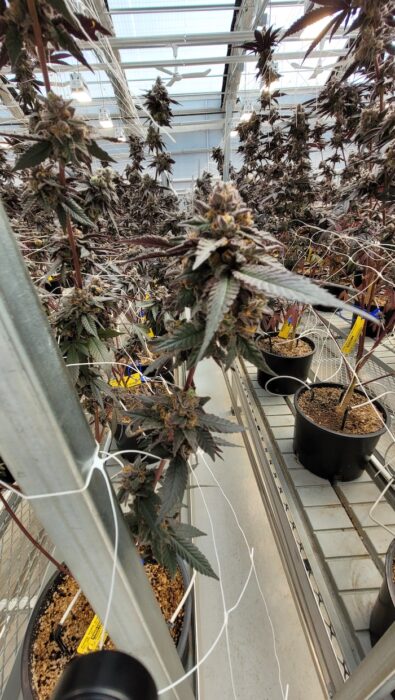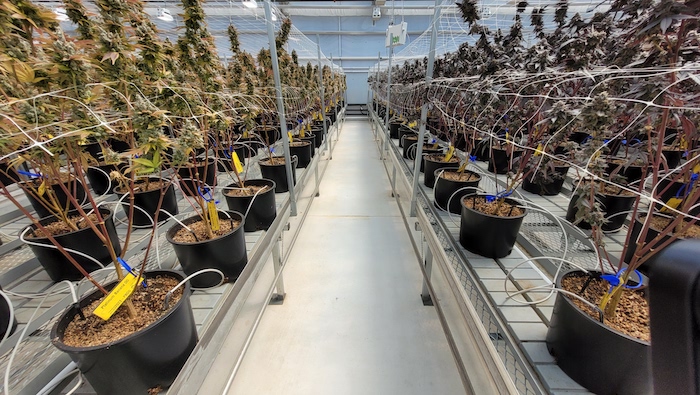
“Every agricultural, horticultural operation in the world is using the sun; nobody is growing indoors, so why should cannabis be any different?”
Months before I got a chance to visit the Suncrafted grow, dispensary, and manufacturing spot in person, friends as well as terp dork connoisseurs recommended I check out their unique red facility down a long leafy driveway off 495 in Middleborough.
I’ve heard buzz about Suncrafted’s greenhouse buildout which delivers natural light to more than 80% of their indoor operation, and about how their dispensary has an illuminated ceiling worth defying gravity and dancing on. Also, their Mountain Top Mint and Garlic Budder concentrates upset multiple top extraction labs at the NECANN Cup in March to win first and third place in the solventless category after just four months in business.
“That was just from pheno-hunted strains,” Tim McNamara said during my visit in late May. The president of HHG, the Mass-based parent company of Suncrafted, McNamara was excited to get up and growing in 2022 after several years of long waits and runways, but is even more amped about strains like Cheetah Piss and Platinum Banana OG that we saw in their grow and are perfectly dank, stank, and dazzling, with the latter plants yielding fat juicy pineapple missiles that could hold down a centerfold. He added, “When we brought in our real genetics which started coming down after the contest, our rosin and lab manager Tim basically said he’s got a new winner already.”








As for that crystal-clear canopy, McNamara said the greenhouse “came about for a lot of reasons, one being we went to a lot of facilities that had no windows.” Those visits led the HHG team to consider natural lighting in the interest of fostering a positive work environment. And then there’s the obvious reason: “We decided to cut out the middleman,” he said of more costly standard energy sources. “Every agricultural, horticultural operation in the world is using the sun; nobody is growing indoors, so why should cannabis be any different?”
In addition to the indoor-outdoor hybrid rooms with sunny ceilings and secondary lighting rigged to kick in when Mother Nature takes an unexpected or unusually prolonged nap, HHG also has nearly an acre of outdoor cannabis processing and cultivation on site. This year it’s the domain of Dave DeWitt, a legendary Cape Cod farmer and advocate for independent agriculture. DeWitt also has his own cannabis cultivation license with the company Outer Cape Cannabis Connection in Truro, and said that his approach has certain elements that are consistent—whether he is growing corn and kale on Cape Cod or Mandarin Cookies in Middleborough.
“[We] increase the biology in the soil so that they can communicate with the plant’s mineral component of the sand, silt, and clay and the organic matter in the soil,” DeWitt explained. “There’s a communication that happens with the biology—between the substance of the soil and the plants. The plants communicate via exudates with the biology and then the biology goes and gets the nutrients they need to keep them healthy.”
When we spoke in May, he said he was less than two weeks away from having the entire outdoor grow planted. DeWitt added, “We can increase and foster the genetics that are innately in those plants by giving it a natural system like this, where we’re growing in the soil with the sun and utilizing biology as opposed to chemical fertilizers.”
I don’t recklessly throw the word sustainable around—especially when it comes to the cannabis industry. There are far more landfills than solutions in sight, and the problem can seem as daunting as corporate considerations to cut back on waste can appear superficial. With that said, Suncrafted really is watching its footprint in many departments in ways that stand out from most other brands.


“When it comes to packaging it’s just overkill with the state,” McNamara said. They haven’t let cumbersome restrictions hold them back though, and are working with different alternative manufacturers on developing improved plant-based container coatings for freshness and also fielding samples from various sustainable packaging companies.
“Some [suppliers] say [their jars] are compostable,” McNamara said. “I’ve ordered samples and we’re actually testing them in our compost out back.”
Their sustain brain also extends to sourcing and edibles, with Kitchen Lead Justin Weiner spinning their recipe for gummies from agave sugar and Mass cranberries.





“I’ve been making the scratch puree that’s going into the cranberry [gummies],” Weiner said. “We’re trying to give back to the community by using more local products, and also the flavor can’t be beat—putting that into the gummies really takes it to the next level and gives it that scratch-kitchen feel.”
“This is the region where basically everybody’s got a cranberry bog in their backyard,” McNamara said. “We [started by using] cranberry seed oil in our tinctures, and then when we started making gummies, they had a concentrate available. … Cranberries are used in a lot of applications for vitamin C supplements and things like that, so as we’re focusing on medicine and sustainability, cranberry flavoring just made sense.”

























